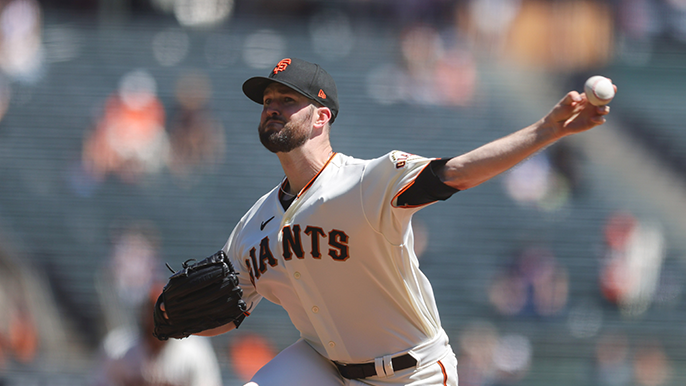
SCOTTSDALE, Ariz. — Playing catch wasn’t just playing catch this winter for Alex Wood.
In Atlanta, where the veteran lefty resides during the offseason, Wood played catch with a focused purpose. He’d constantly remind himself to raise his arm higher than he’s used to, to get his hand more behind the baseball, to accentuate an over-the-top motion.
In doing so, Wood tried to etch new muscle memory into a delivery that’s served him well for a 10-year career that has included an All-Star selection. This winter, mostly on his own, Wood sought to raise his arm slot significantly, with the goal of creating a more repeatable and dangerous shape on his main weapon: the slider.
“My pitch shapes, because of my slots, are naturally affected by raising my slot,” Wood told KNBR on Feb. 24. “So it wasn’t necessarily that I was forcing or trying to shape my slider differently, it’s just by raising my slot a little bit, it naturally has progressed my slider to more of an ideal shape for me.”
Wood, 32 and coming off a season with a 5.15 ERA — his highest in any full season as a starter — said he’s aiming to raise his arm slot three-to-five inches. The adjustment, during a time of mass adjustments league-wide in the wake of wholesale rule changes, could elevate Wood back to his 2021 performance, when he racked up 152 strikeouts in 138.1 innings as a key member of San Francisco’s rotation.
“The consistency of his slider shape is something that we’re trying to really harness,” Giants pitching coach Andrew Bailey told KNBR. “It’s his best swing-and-miss pitch, and the ability to consistently produce that shape and execute it where he needs to, this should be able to help him do that for sure.”
Wood’s offseason began with physical therapy four times per week. He finished the season on the injured list with a shoulder impingement, which he gutted through for several starts before the club eventually shut him down on Sept. 3.
That injury, Wood explained, limited the range of motion in his arm. The scapula muscle — located at the top of your rib cage on your backside — was too tight, preventing his shoulder from rotating properly.
“Yeah, you feel it, but your brain’s kind of telling your arm what throw to make, but just not being able to actually make that throw your brain’s telling your arm because you’re just inhibited a little bit,” Wood said.
In six August starts leading up to his season-ending injured list designation, Wood allowed 28 earned runs in 30 innings. His 8.40 ERA in that stretch was by far the worst of any month in 2022 and boosted his season mark almost an entire point.
During those starts, Wood — a pitcher with a low arm slot to begin with — felt his release point drop even deeper.
According to Baseball Savant, Wood’s average release point last year was four feet, eight inches off the ground. That number was lowered by pitching through the shoulder impingement.
“It really affected the consistency of the shape of my slider,” Wood said. “The lower you are, the harder it is to shape breaking pitches consistently.”

When he’s right, Wood said his release point is roughly 5-foot-1 or 5-foot-2. In bullpen sessions this spring, he said he’s been anywhere from 5-foot-4 to 5-foot-6 — a substantial jump.
Many pitchers are constantly tinkering and some use the offseason for more drastic changes. Sean Manaea, for example, added several ticks on his fastball velocity by working on his pliability at Driveline — a popular data-driven performance lab — in Scottsdale this winter.
Wood’s efforts were more self-determined. Though he has trained with Driveline in the past, staying home in Atlanta was the preferred option. Wood and his wife, Suzanna, had their first child, a baby boy named Asa, in September.
So there, he’d play catch and execute his regimented throwing program. In Scottsdale, he worked with weighted balls, throwing them at a brick wall. All with the new release point in the back of his mind.
“Trying to just dominate the offseason as much as I could to come back stronger, healthier than ever,” Wood said.
The intention of the change is to throw better sliders more consistently. Last year, opposing batters hit .254 against the pitch compared to .184 against it in 2021. It could also add some different vertical movement on his sinker, Wood said.
“My slider has really been the ideal shape,” Wood said. “Last year, I was probably more of a gyro slider, and now I’m getting more depth – two-three vert. Getting more sweep to my slider. Again, getting like four-to-six inches of sweep on average in my pen.”
Gyro sliders, one of two main variations of the pitch, are known to break late and sharply. Sweeping sliders, the other type — the one Wood is striving for — have more of a frisbee, horizontal movement.
Wood’s estimations are imperfect because he hadn’t yet thrown with Trackman cameras tracking data at the time, but if he’s getting six inches of sweep on his slider, that would be two more than he averaged in 2022, per Baseball Savant.
In his first Cactus League start, the first time Wood has thrown competitively after this winter’s alterations, the southpaw fanned five of the six batters he faced in two perfect innings.
“Woody’s been, over the course of his career, he’s been at multiple release slots,” Bailey said. “Just getting to the one that he’s most comfortable with and can keep him healthy…I’m excited for him.”

